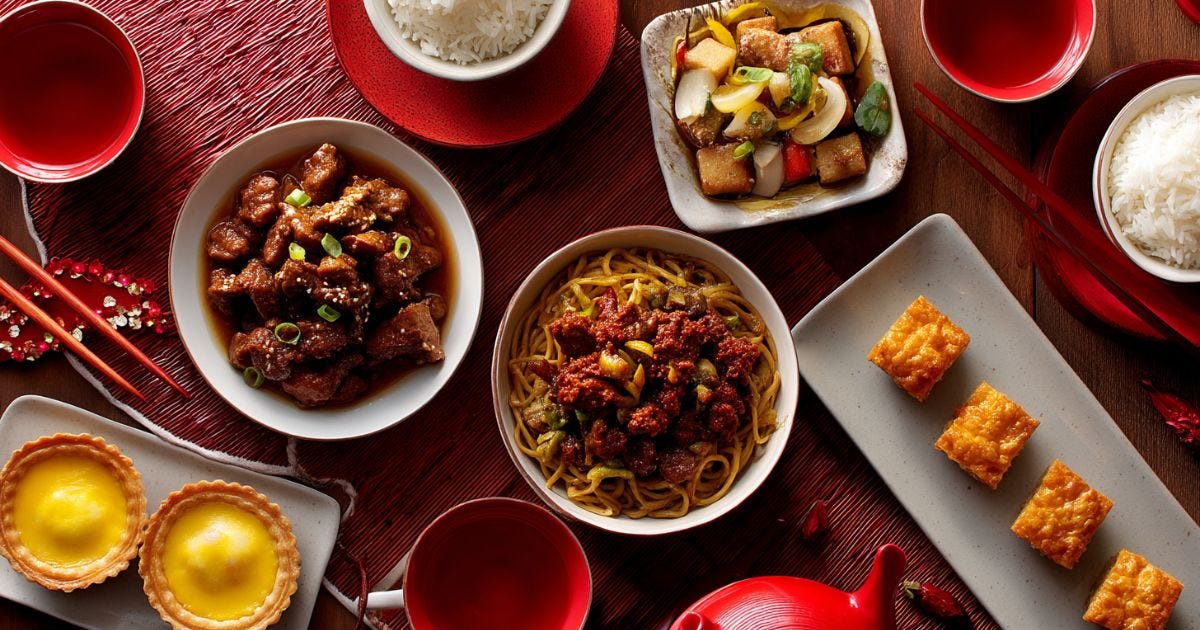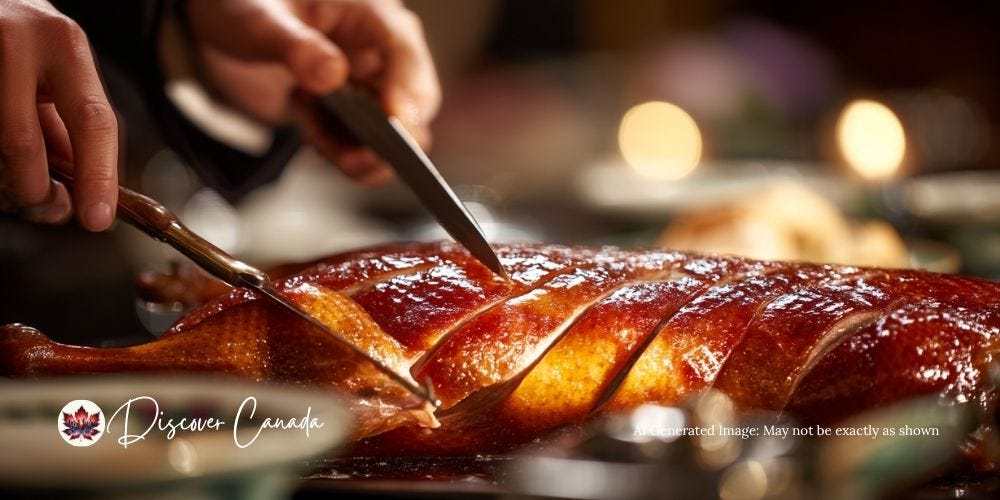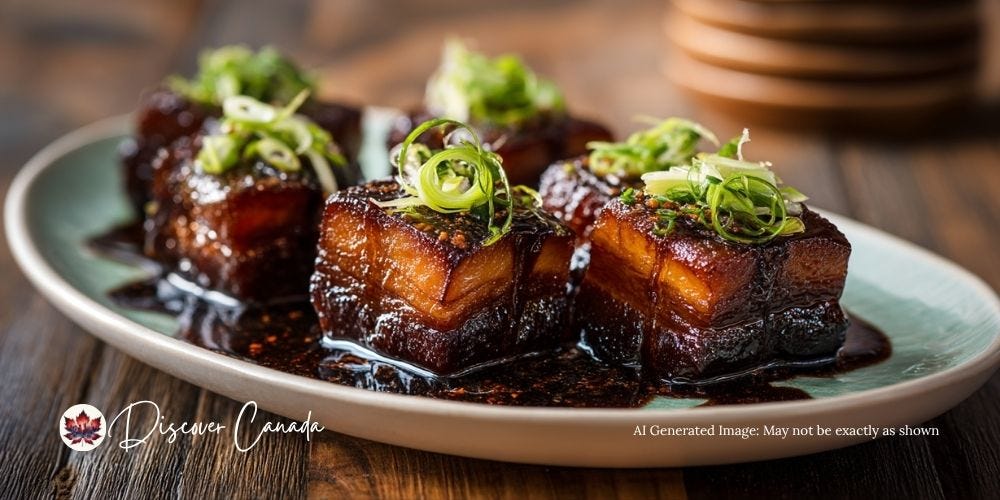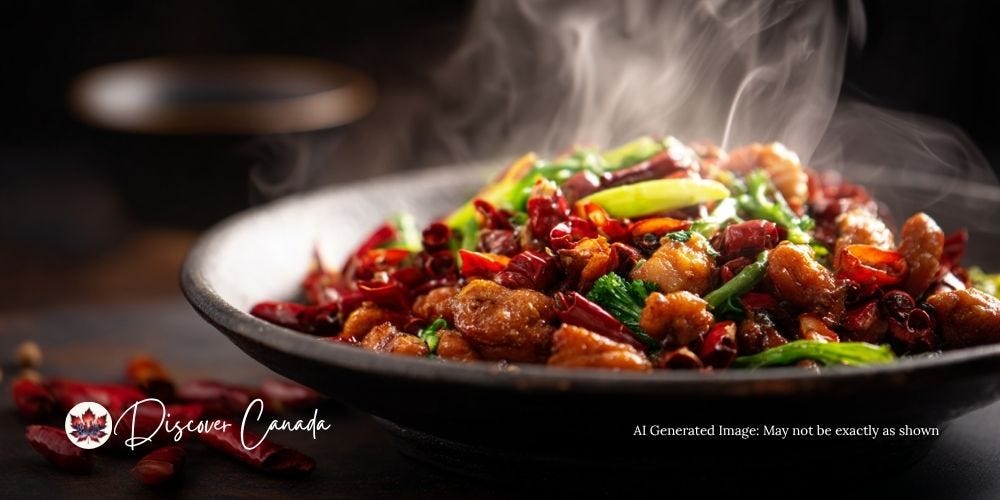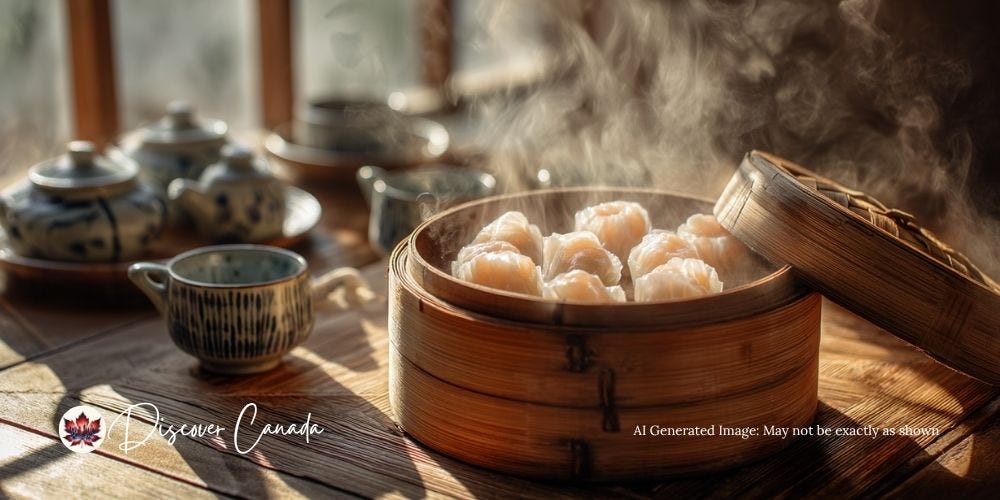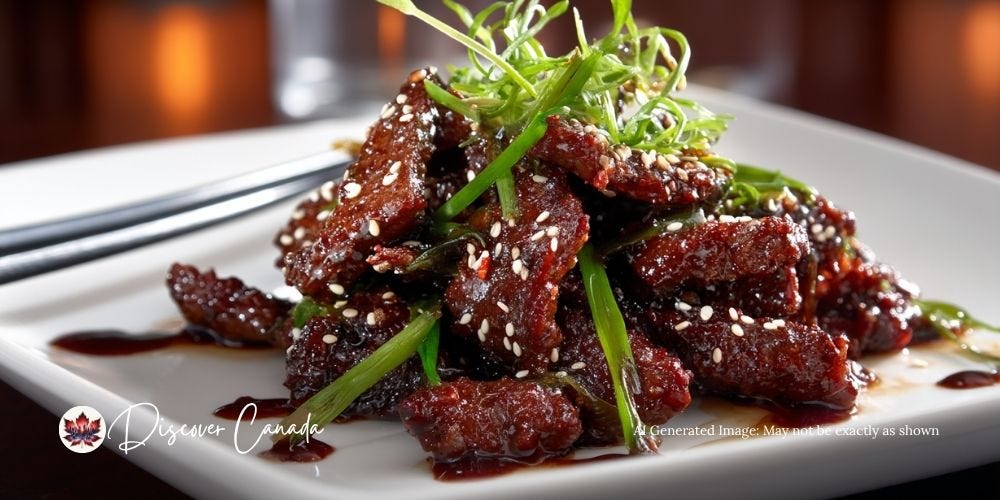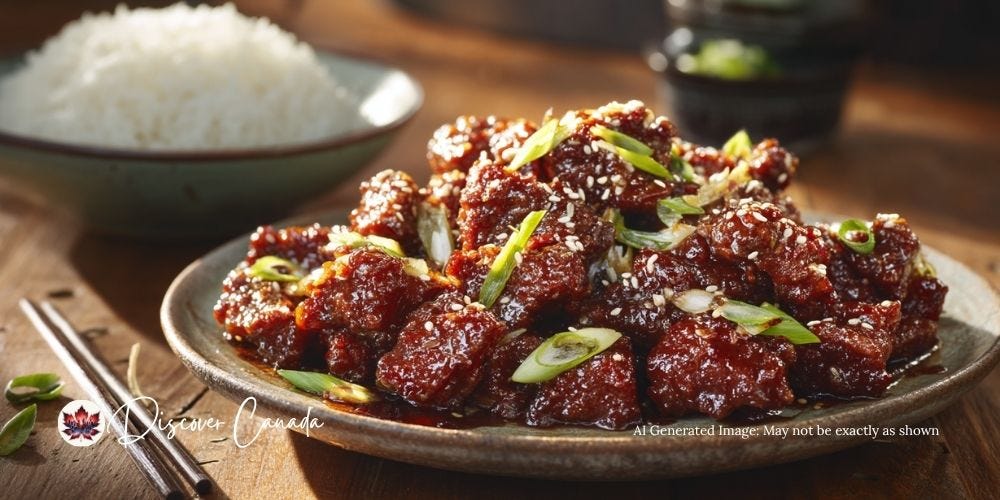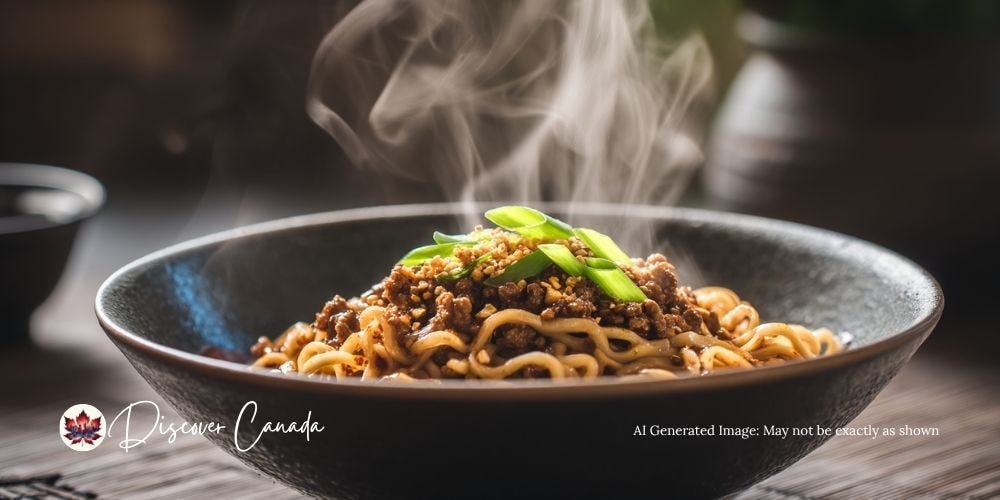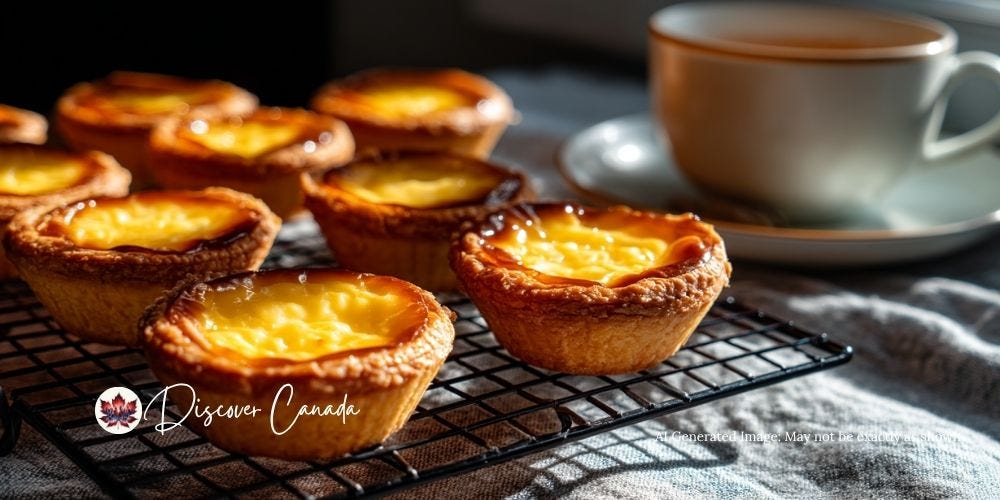Chinese Cuisine in Canada: From Chop Suey to Ginger Beef
From dim sum roots to modern Canadian flavour
🎧 Listen While You Read
Hit play and let the sounds of sizzling woks and clinking teacups set the mood as we journey through Canada’s Chinatowns — from neon-lit alleys to family-run kitchens where history is still served hot.
Canada on a Plate: Chinese Cuisine in Canada
Introduction — Steam, Lanterns, and Legacy
The red lanterns sway gently in Vancouver’s Chinatown as evening rain slicks the streets. Steam rises from the barbecue window, glistening against the glow of soy-lacquered duck. Inside, conversations flow in Mandarin, Cantonese, English — a blend as unmistakable as the aroma of garlic, sesame, and ginger drifting into the night.
Chinese food in Canada is more than a cuisine — it’s a chronicle of adaptation and belonging. It tells the story of early migrants who cooked to survive, of families who built communities one dumpling at a time, and of new generations reimagining old traditions. From prairie ginger beef to Michelin-starred dim sum, every plate carries a memory — of journeys taken, roots re-planted, and flavours that found a new home.
✨ Key Takeaways
🥢 Explore seven iconic restaurants from Vancouver to Halifax, each telling its own chapter of Chinese-Canadian culinary history.
🍛 Learn how dishes like ginger beef, chop suey, and Hunan dumplings became national comfort food.
🍜 Discover four DIY recipes to recreate Canada’s favourite Chinese dishes at home.
🏮 Celebrate the evolution of Chinatown culture — from resilience to renaissance — across Canada’s cities.
A Taste That Built a Nation
When the first waves of Chinese immigrants arrived in the mid-1800s, they brought with them little more than a few keepsakes, recipes from home, and the determination to build a new life. They laboured on the Canadian Pacific Railway, mined for gold in the Fraser Canyon, and cooked in remote logging camps and prairie towns — often with ingredients that were unfamiliar or scarce.
Out of that scarcity came invention. Fresh bok choy was replaced by cabbage, and oyster sauce by soy and sugar. Thus began a culinary evolution that would quietly define generations. The result wasn’t traditional Chinese cuisine — it was something uniquely Canadian.
By the early 1900s, Chinatowns had begun to take root in Victoria, Vancouver, and Calgary. Narrow streets filled with the scent of sesame oil and the chatter of shopkeepers, offering a small taste of home in a foreign land. These neighbourhoods became both refuge and marketplace, where food spoke the universal language of comfort.
In the decades that followed, Chinese cafés appeared in small towns from Moose Jaw to Moncton, serving steaming plates of ginger beef, sweet-and-sour pork, and chop suey. They were places where truckers, miners, and families alike gathered — not for authenticity, but for connection.
Today, Chinese cuisine in Canada stands as one of the country’s great cultural bridges — evolving from necessity into artistry, from survival into celebration. And in kitchens from coast to coast, that story continues to unfold, one plate at a time.
Across Canada’s Chinatowns — Seven Restaurants, Seven Stories
Step into any Chinatown across the country, and you’ll find that each one hums with its own rhythm — sizzling woks, laughter echoing through narrow alleys, the faint smell of roasted duck carried on the wind. These aren’t just restaurants; they’re storytellers, each serving a plateful of memory and migration.
From the neon glow of Vancouver’s East Pender Street to the harbour lights of Halifax, these seven kitchens trace a journey across both geography and time — proof that food remains one of Canada’s truest languages of belonging.
Vancouver, British Columbia — Mott 32
In the heart of downtown Vancouver, Mott 32 glimmers with copper tones and quiet luxury. Beneath its intricate chandeliers and lattice screens, diners gather to share dishes that are as elegant as they are rooted in heritage. Named after the first Chinese convenience store in New York’s Chinatown, this restaurant represents the global evolution of Chinese cuisine — refined, confident, and proudly cross-cultural.
Each plate tells a story of patience and perfection. The apple-wood-roasted Peking duck arrives carved tableside, its skin lacquered and crisp. The crispy triple-cooked wagyu short ribs are both tender and indulgent, while delicate dim sum baskets reveal the precision of Hong Kong-style technique. It’s the kind of dining that reminds you how far Chinese cuisine has travelled — from railway camps to rooftop fine dining.
Main Menu Offerings:
Apple-wood roasted Peking duck
Crispy wagyu short ribs
King prawn har gow (dim sum)
Black truffle siu mai
Signature Singapore noodles
Vancouver, British Columbia — Bao Bei Chinese Brasserie
Tucked into a quiet corner of Vancouver’s Chinatown, Bao Bei feels like a love letter — not just to Chinese food, but to the people who carried it across oceans. The space is intimate, glowing with soft light and old photographs, the air scented with star anise and ginger. Here, heritage meets the heartbeat of the modern city.
Chef Joanne Chang weaves together memories of family cooking with contemporary flair. You might start with Shaoxing wine–braised pork belly, or delicate pot stickers, pan-seared until golden. Every bite feels intentional — nostalgic yet adventurous. And while the dishes nod to generations past, the cocktails and energy are entirely of the present, making Bao Bei a gathering place for both old souls and curious newcomers.
Main Menu Offerings:
Shaoxing wine–braised pork belly
Crispy pot stickers
Taiwanese-style fried chicken
Fried rice with Chinese sausage and scallions
Chrysanthemum tea cocktail
Toronto, Ontario — Sunnys Chinese
Hidden down an unmarked alley in Toronto’s Kensington Market, Sunnys Chinese hums with the energy of a city constantly reinventing itself. Here, Chef David Schwartz and his team explore the bold, unapologetic flavours of regional Chinese cuisine — from the numbing heat of Sichuan peppercorns to the deep savoury notes of Xi’an-style noodles.
There’s an easy confidence to this kitchen — no fusion, no compromise, just food that celebrates its roots while thriving in its new home. On any given night, you’ll find diners leaning over steaming bowls of chilli chicken, chopsticks clinking against ceramic, laughter spilling out into the market. Sunnys feels like a statement: Chinese food in Canada has never been more vibrant, more diverse, or more alive.
Main Menu Offerings:
Spicy Sichuan noodles
Chongqing chilli chicken
Dry-fried green beans with minced pork
Cumin lamb skewers
Cold sesame noodles
Montreal, Quebec — Le Piment Rouge
In the heart of Old Montreal, where cobblestone streets echo with history, Le Piment Rouge stands as both legacy and revival. Once a cornerstone of fine dining in the 1980s, this institution helped define Chinese cuisine for a generation of Montrealers — introducing the city to elegant Cantonese banquets and the now-famous Hunan dumplings drizzled in peanut sauce.
Today, the restaurant’s return is a quiet celebration. The décor remains timeless — red lacquer, silk screens, and white tablecloths — while the menu bridges eras. You’ll still find the classics that built its reputation, but with new life breathed into every bite. It’s the story of Chinese-Canadian food itself: traditions honoured, recipes reborn, and history remembered through flavour.
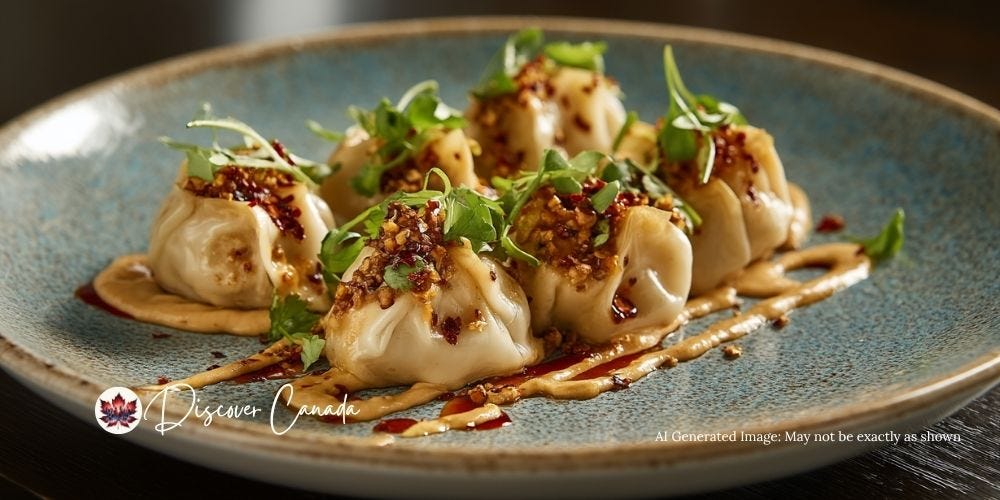
Main Menu Offerings:
Hunan dumplings with peanut butter sauce
Cantonese roast duck
Lobster with ginger and scallion
Sweet-and-sour pork tenderloin
House fried rice with egg and shrimp
Winnipeg, Manitoba — Kum Koon Garden
On any given Sunday morning, Kum Koon Garden hums like a symphony. Steam curls from rolling carts, the air fragrant with shrimp, garlic, and freshly brewed tea. Families fill the round tables, sharing dim sum as servers glide past with trays of dumplings and rice rolls. It’s a ritual as comforting as it is delicious — one that’s defined Winnipeg’s Chinatown for decades.
Kum Koon is more than a restaurant; it’s a gathering place where generations meet. The grand dining room, lined with golden accents and circular chandeliers, captures the feeling of a celebration every day of the week. Whether it’s barbecued pork buns or steamed siu mai, every plate here tells a story of tradition carried forward with quiet pride.
Main Menu Offerings:
Classic dim sum carts (siu mai, har gow, steamed buns)
Cantonese-style barbecue duck
Crispy noodles with beef and vegetables
Shrimp rice rolls with sweet soy
Mango pudding
Winnipeg, Manitoba — Dragon Palace
A few miles from downtown, Dragon Palace is what every city needs — a neighbourhood favourite where the scent of ginger and soy sauce feels like home. It’s the kind of restaurant where the lights are warm, the plates come out fast, and the servers know their regulars by name.
This is Canadian-Chinese comfort food at its finest. The portions are generous, the flavours nostalgic, and every dish arrives with the familiar balance of sweet, savoury, and crisp. Their ginger beef, in particular, is a city legend — spicy, sticky, and utterly addictive. It’s a dish that bridges prairie practicality with Chinese ingenuity, born of adaptation and kept alive through affection.
Main Menu Offerings:
Calgary-style ginger beef
Lemon chicken
Sweet-and-sour pork
Beef and broccoli stir-fry
Fried rice with barbecue pork
Halifax, Nova Scotia — Look Ho Ho
In the harbour city of Halifax, Look Ho Ho has been serving plates of nostalgia since 1959. Its bright yellow sign and cozy booths haven’t changed much in decades, and that’s precisely the charm. Step inside, and it’s like entering a time capsule of Canadian-Chinese dining — from the sizzling chop suey to the perfectly crisp egg rolls.
This family-run favourite has weathered generations, wars, and waves of change, all while holding on to the simple idea that food is comfort. The menu reads like a love letter to the mid-century heyday of Chinese cafés — hearty, familiar, and always satisfying. Look Ho Ho remains proof that good food and good memories never go out of style.
Main Menu Offerings:
Classic chop suey
Sweet-and-sour ribs
Egg rolls with plum sauce
Chicken chow mein
Fried rice with shrimp and green onion
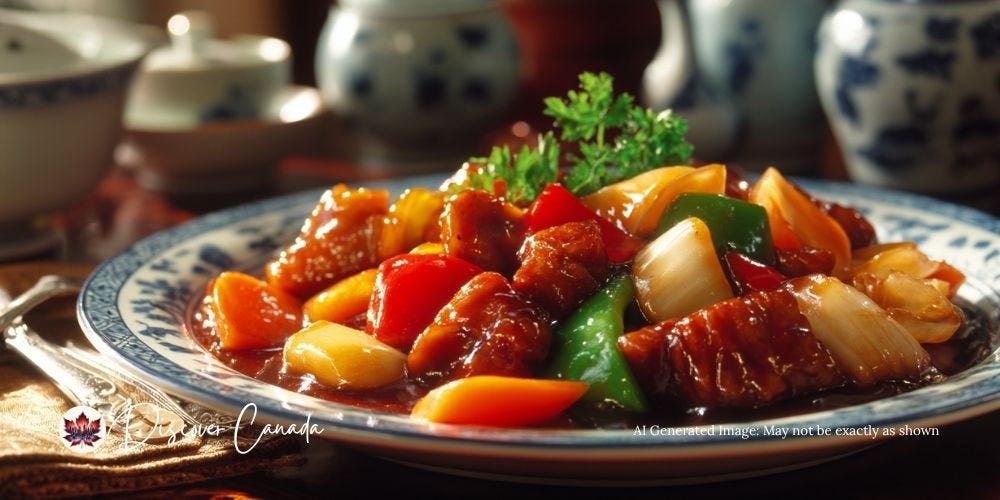
DIY Recipes – Bring the Flavours Home
Chinese food in Canada isn’t just eaten — it’s shared, adapted, and reinvented at every kitchen table. These four recipes capture that journey: some born on Canadian soil, others carried across oceans, all part of the same story.
Calgary Ginger Beef
It began in the 1970s at Calgary’s Silver Inn, where chef George Wong turned necessity into invention. What started as a stir-fry became Canada’s most iconic Chinese dish — sweet, spicy, crispy perfection.
Ingredients
1 lb flank steak, thinly sliced against the grain
1 egg white
¼ cup cornstarch
1 tbsp soy sauce
½ tsp salt
Vegetable oil, for frying
Sauce:
3 tbsp soy sauce
2 tbsp rice vinegar
3 tbsp sugar
1 tbsp hoisin sauce
1 tbsp grated fresh ginger
2 cloves garlic, minced
½ tsp red chilli flakes (or to taste)
Directions
Toss beef with egg white, cornstarch, soy sauce, and salt. Let it sit for 20 minutes.
Mix the sauce ingredients in a small bowl and set aside.
Heat oil in a wok or deep skillet over medium-high heat. Fry beef in batches until crisp and golden. Drain on paper towels.
Remove excess oil, leaving 1 tbsp in the wok. Add ginger and garlic; cook 30 seconds.
Pour in the sauce, simmer briefly until thickened.
Return beef to the wok and toss to coat evenly. Serve hot over steamed rice.
General Tso’s Chicken
Crispy, sweet, tangy, and just a little fiery — this dish has travelled the world, but in Canada, it’s right at home on countless takeout menus and dinner tables.
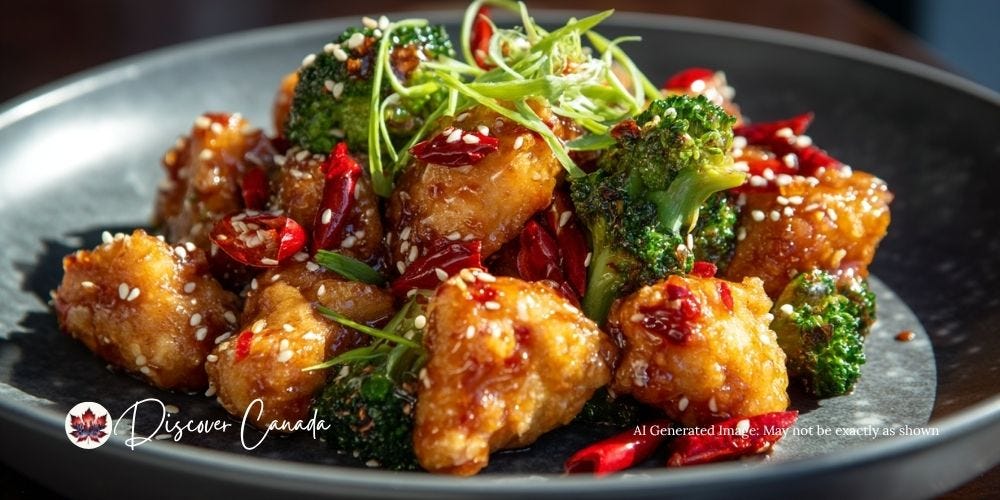
Ingredients
1½ lbs boneless chicken thighs, cut into bite-size pieces
1 egg
½ cup cornstarch
½ tsp salt
½ tsp pepper
Vegetable oil, for frying
Sauce:
3 tbsp soy sauce
2 tbsp rice vinegar
3 tbsp brown sugar
2 tbsp hoisin sauce
1 tsp sesame oil
1 tbsp cornstarch + 2 tbsp water (slurry)
2 cloves garlic, minced
1 tbsp grated fresh ginger
½ tsp crushed red chilli flakes (optional)
Directions
In a bowl, whisk egg, salt, and pepper. Add chicken, toss to coat, then dredge in cornstarch.
Heat 1 inch of oil in a wok or deep pan. Fry chicken in batches until golden and crisp. Drain.
In a clean wok, heat 1 tbsp oil. Add garlic, ginger, and chilli flakes; sauté 30 seconds.
Whisk sauce ingredients (except slurry) and pour into the wok. Bring to a simmer.
Stir in cornstarch slurry until sauce thickens.
Return chicken to the wok and toss until coated. Serve with steamed rice or broccoli.
Dan Dan Noodles
Street food turned comfort classic, these Sichuan noodles are bold, nutty, and slightly spicy — the kind of dish that tastes like it’s been simmering in memory.
Ingredients
10 oz Chinese wheat noodles (or spaghetti)
½ lb ground pork (or mushrooms for vegetarians)
2 tbsp vegetable oil
2 cloves garlic, minced
1 tsp grated ginger
2 green onions, chopped
1 tbsp Sichuan peppercorns (optional, for authentic numbing heat)
Sauce:
3 tbsp soy sauce
2 tbsp chilli oil (more for spice lovers)
1 tbsp sesame paste or peanut butter
1 tbsp black vinegar (or rice vinegar)
1 tsp sugar
1 tbsp toasted sesame seeds
Directions
Cook noodles according to package directions. Drain and set aside.
Heat oil in a wok over medium heat. Add Sichuan peppercorns (if using) and fry briefly to release aroma; remove them before they burn.
Add garlic, ginger, and ground pork. Stir-fry until browned and crumbly.
Whisk together the sauce ingredients in a bowl. Add to the wok and simmer 1 minute.
Toss noodles in the sauce until coated and glossy.
Top with chopped green onions and extra chilli oil. Serve warm.
Hong Kong Egg Tarts
A little sweet, a little silky — these egg tarts have been a staple in dim sum parlors for generations. They’re delicate enough for afternoon tea, and easy enough for any weekend baker.
Ingredients
1 sheet puff pastry (store-bought, thawed)
½ cup water
⅓ cup sugar
3 large eggs
½ cup evaporated milk
½ tsp vanilla extract
Directions
Preheat oven to 400°F (200°C). Roll puff pastry and cut into circles to fit muffin tins or tart moulds. Press gently into place.
In a saucepan, heat water and sugar until dissolved. Cool slightly.
In a bowl, whisk eggs, milk, and vanilla. Stir in cooled sugar syrup; strain the mixture for a silky custard.
Pour custard into shells, filling about ¾ full.
Bake for 20–25 minutes, until the pastry is golden and the custard is just set (a slight wobble in the center is perfect).
Cool slightly before serving warm.
From Chop Suey to Michelin Stars
From the rough-hewn kitchens of railway camps to the gleaming dining rooms of Michelin-honoured restaurants, Chinese cuisine in Canada has travelled a remarkable road. What began as sustenance for workers far from home became an invitation — one that every Canadian eventually accepted, one plate at a time.
The dishes may have changed — chop suey giving way to dan dan noodles, ginger beef sharing the table with dim sum — but the heart of it all remains the same: food that connects, comforts, and reminds us of where we’ve been.
Every Chinatown, from Vancouver’s neon glow to Halifax’s quiet waterfront, holds its own story of perseverance and pride. Behind every wok and wooden spoon is a family that carried its heritage across oceans and found a way to make it feel at home here.
Today, as new generations of chefs blend innovation with respect, Chinese-Canadian cuisine stands not just as a culinary tradition, but as a cultural bridge — proof that recipes can travel farther than any map can measure.
And somewhere between a plate of Hunan dumplings and a warm egg tart, you’ll taste more than flavour. You’ll taste legacy — sweet, savoury, and unmistakably Canadian.



